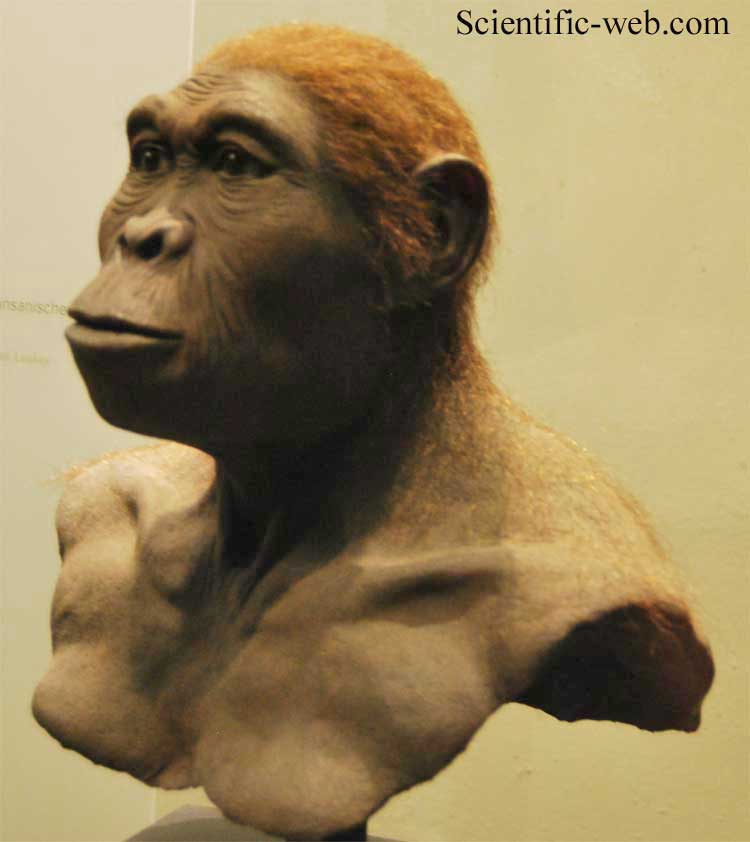Homo habilis, Photo: Michael Lahanas Cladus: Eukaryota Name Homo habilis Leakey et al, 1964 Vernacular names Homo habilis (play /ˈhoʊmoʊ ˈhæbɨlɪs/, "Handy-man") is a species of the genus Homo, which lived from approximately 2.3 to 1.4 million years ago at the beginning of the Pleistocene period.[1] The discovery and description of this species is credited to both Mary and Louis Leakey, who found fossils in Tanzania, East Africa, between 1962 and 1964.[2] Homo habilis (or possibly H. rudolfensis) was the earliest known species of the genus Homo until May 2010, when H. gautengensis was discovered, a species believed to be even older than H. habilis.[3] In its appearance and morphology, H. habilis is thus the least similar to modern humans of all species in the genus (except possibly H. rudolfensis). H. habilis was short and had disproportionately long arms compared to modern humans; however, it had a less protruding face than the australopithecines from which it is thought to have descended. H. habilis had a cranial capacity slightly less than half of the size of modern humans. Despite the ape-like morphology of the bodies, H. habilis remains are often accompanied by primitive stone tools (e.g. Olduvai Gorge, Tanzania and Lake Turkana, Kenya). Homo habilis has often been thought to be the ancestor of the more gracile and sophisticated Homo ergaster, which in turn gave rise to the more human-appearing species, Homo erectus. Debates continue over whether H. habilis is a direct human ancestor, and whether all of the known fossils are properly attributed to the species. However, in 2007, new findings suggest that the two species coexisted and may be separate lineages from a common ancestor instead of H. erectus being descended from H. habilis.[4] Findings One set of fossil remains (OH 62), discovered by Donald Johanson and Tim White in Olduvai Gorge in 1986, included the important upper and lower limbs.[5] Their finding stimulated some debate at the time.[6] An older (1963) finding from the Olduvai site found by N. Mbuika had included a lower jaw fragment, teeth and upper mandible possibly from a female dating 1.7 million years old. The remains from 3 skeletons stacked on top of each other[7] demonstrated australopithecine-like body with a more human-like face and smaller teeth. Compared to australopithecines, H. habilis's brain capacity of 363 and 600 cm³ was on average 50% larger than australopithecines, but considerably smaller than the 1350 to 1450 cm³ range of modern Homo sapiens. These hominins were smaller than modern humans, on average standing no more than 1.3 m (4 ft 3 in) tall. The small size and rather primitive attributes have led some experts (Richard Leakey among them) to propose excluding H. habilis from the genus Homo, and renaming as "Australopithecus habilis". KNM ER 1813 KNM ER 1813 is a relatively complete cranium which dates 1.9 million years old, discovered at Koobi Fora, Kenya by Kamoya Kimeu in 1973. The brain capacity is 510 cm³, not as impressive as other early specimen and forms of Homo habilis discovered. OH 7 dates 1.75 million years old and was discovered by Jonathan Leakey on November 4, 1960 at Olduvai Gorge, Tanzania. It is a lower jaw complete with teeth and due to the size of the small teeth; researchers estimate this juvenile individual had a brain volume of 363 cm³. Also found were more than 20 fragments of the left hand. Tobias and Napier assisted in classifying OH-7 as the type fossil. OH 24 OH 24 (AKA Twiggy) is a roughly deformed cranium dating 1.8 million years old discovered in October 1968 at Olduvai Gorge, Tanzania. The brain volume is just under 600 cm³; also a reduction in a protruding face is present compared to members of more primitive Australopithecines. KNM ER 1805 KNM ER 1805 is a specimen of an adult H. habilis made of 3 pieces of cranium dating 1.74 million years old from Koobi Fora, Kenya. Previous assumptions were that this specimen belongs to H. erectus based on the degree of prognathism and overall cranial shape. Interpretations
Most experts assume the intelligence and social organization of H. habilis were more sophisticated than typical australopithecines or chimpanzees. Yet despite tool usage, H. habilis was not the master hunter that its sister species (or descendants) proved to be, as there is ample fossil evidence that H. habilis was a staple in the diet of large predatory animals such as Dinofelis, a large scimitar-toothed predatory cat the size of a jaguar.[8] H. habilis used tools primarily for scavenging, such as cleaving meat off carrion, rather than defense or hunting. Homo habilis is thought to be the ancestor of the lankier and more sophisticated Homo ergaster, which in turn gave rise to the more human-appearing species Homo erectus. Debates continue over whether H. habilis is a direct human ancestor, and whether all of the known fossils are properly attributed to the species. Homo habilis co-existed with other Homo-like bipedal primates, such as Paranthropus boisei, some of which prospered for many millennia. However, H. habilis, possibly because of its early tool innovation and a less specialized diet, became the precursor of an entire line of new species, whereas Paranthropus boisei and its robust relatives disappeared from the fossil record. Homo habilis may also have coexisted with Homo erectus in Africa for a period of 500,000 years.[9] Notes ^ New York Times article Fossils in Kenya Challenge Linear Evolution published August 9, 2007 says "Scientists who dated and analyzed the specimens — a 1.44 million-year-old Homo habilis and a 1.55 million-year-old Homo erectus — said their findings challenged the conventional view that these species evolved one after the other. Instead, they apparently lived side by side in eastern Africa for almost half a million years." References Early Humans (Roy A. Gallant)/Copyright 2000 ISBN 0-7614-0960-2 Source: Wikipedia, Wikispecies: All text is available under the terms of the GNU Free Documentation License |
|

